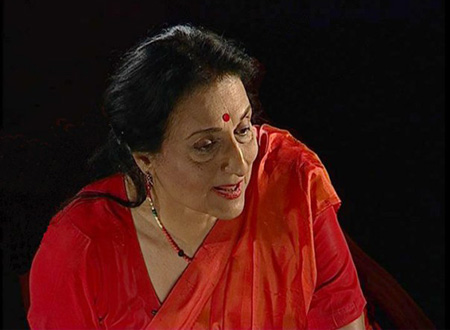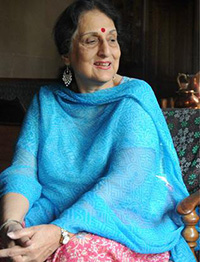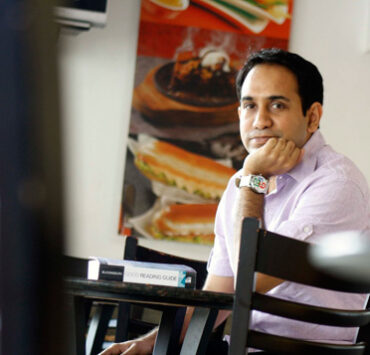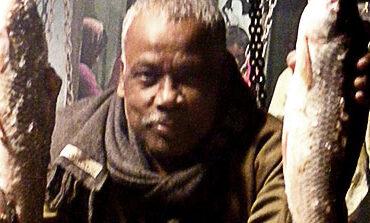She has, along with daughter Anasuya and husband Gopal Sharman, staged their political satire, Let’s Laugh Again, during the Emergency to incredulous packed houses for a six month run, until the Emergency itself collapsed. The family’s Akshara Theatre in the centre of New Delhi, a landmark architectural creation, built and designed by Sharman, rose from a chance performance before the then President of India Dr. S. Radhakrishnan. Her daughter, Anasuya, was the first female artist and first foreigner to light Broadway.
Jalabala Vaidya is walking history. We caught up with the renowned theatre personality for an exclusive interview. Read on for excerpts —

Jalabala Vaidya.
How did you and your husband get your start in the theatre world?
We are theatre people, both performers and playwrights. When he was younger, Gopal was an editor for the Sunday Standard as a freelance writer. He wrote a very popular column on the Upanishads and questions on philosophy, life, and death under a pseudonym, Nachiketas. Unbeknownst to us, president Radhakrishnan was a regular reader of this column. When he had his cataract operation and was unable to read the column, he sent an old friend of his, Professor K. Subramaniam, formally chief editor of the Indian Express, to find out who Nachiketas was, and invited him to come to the President’s residence and read aloud the columns he had missed during his recovery period. We were ecstatic of course. But Gopal was not confident about his reading skills. So he told me to go read to the President. I had done some acting, so he persuaded me to do it. I used to wear glasses, but I memorised the whole thing so that I wouldn’t have to wear them. I was very vain.
When the president saw me, the first thing he said was — where’s the poet? There was a crowd of intellectuals and professors and I was terribly intimidated, but I carried on. They were tremendously impressed, and president Radhakrishnan said, “You should perform this for the public.” And that was where it all began.
On the President’s recommendation, we performed at Azad Bhavan, headquarters of the Indian Council for Cultural Relations, to which various embassies sent their representatives. We had titled our performance Full Circle after one of Gopal’s published stories. The Italian and Yugoslavian ambassadors requested us to perform in their home countries. It was our first trip to Europe, and while they paid for our lodge and food, they refused to pay for our tickets. So we bought two one-way tickets and we were off.
What were your travels through Europe like?
We travelled extensively throughout Europe. We played and performed; we broke glasses, and got very drunk. We ran to full houses. A Jesuit monk, who had taken a vow of silence, broke it — something he could only do once every three years — to talk to Gopal about our play. We had an audience with the Pope. It was like a dream. We went to London and performed at two famous London theatres: The trendy Arts Laboratory on Drury Lane and The Mercury Theatre, famous for verse productions. It had premiered T. S. Eliot’s Murder in the Cathedral and Christopher Fry’s Ascent of F6, and it was a great honour and recognition for Gopal’s work to be asked to play Full Circle there.
When we were in Rome we were asked to perform for Italian T.V. They paid us so much money, we bought a Volkswagon Beetle and continued our tour by car! We stayed in London for another two years, where Gopal wrote for The Times on the arts, wrote a book on Indian music for the publisher Andre Deutsche and, of course, received our contract from the Royal Shakespeare Company to bring the Ramayana to their World Theatre Season. Then we flew home and shipped the Beetle. We had started an idealistic farming community in Manali before we left. We were so passionate about everything we did. Eventually Gopal’s brother Shree carried it on, since we were now so caught up with theatre.
What, according to you, differentiates Akshara Theatre from other urban theatres?
In most auditoriums in Delhi, you can’t even see the floor of the stage. The difference in Akshara is the steeped seating arrangements. The acoustics are helped by the floor of the stage which is made of teak, rosewood, and hardwood, which gives voices a clear tone. The chairs are also made of wood, which amplifies the mellow sound. Metal reverberates whereas wood does not. We also have two inches of rubber under it. The empty space doesn’t hurt the performers, unlike concrete. The entire complex has been designed and built by Gopal, who thought of all these things.
What was the source of the political turmoil in your professional life?
Sanjay Gandhi attempted to demolish our theatre while we were in America in 1976. Our run on Broadway was in progress at this point. Indira Gandhi, previous to this, was a frequent visitor at the theater. We received no letter or notification regarding this matter when we were touring. The bulldozers were the first notification of the whole matter. We called Indira Gandhi (through her secretary, who was also in New York) from New York. She asked us to return immediately and meet her as soon as we got back. We arrived at 3 a.m. and called her office at 10 in the morning. They told us that she had invited us to tea that day! It was memorable — I remember a young Sonia Gandhi walked in with the tea tray. We were taken aback when Indira asked us, right off the bat: Do you think I’m a dictator? She seemed genuinely upset at the idea and complained that every newspaper had labelled her as one. Of course, we could only make polite noises, at a complete loss for what to say.
Gopal, at this point, had a brilliant idea. He suggested the idea of airing a satire on Doordarshan that would prove that Indira was comfortable with a free media. He said that the show should be free of censorship. Indira Gandhi adored the idea but wanted to to see the show beforehand, so that she could be prepared, as she put it. We declined.
The show filing began in midsummer, the hottest Delhi days. In the middle of shooting, we got a stern letter from her office, demanding to see five minutes of the show. They promised not to change any of it. We went into the living room and encountered the biggest names in Indian politics stuffed into one room, awaiting our presence. They were all there will their little cups of steaming tea, looking grim and quiet. One of them protested that the show would demoralise the bureaucracy. At this point, Maneka Gandhi unexpectedly piped up, saying that if that was true, perhaps the show was required.

Jalabala Vaidya.
What other opposition did you face?
They continued to work against us when we resumed shooting. We were offered “coffee money” at the studios, and we were too naïve to know (until we were informed by a well-wisher) that it was code for bribes. We were also once locked into the studio because they claimed we had worked past the closing time. We had to escape by breaking open a back door. Another time our tape disappeared and we were told that we would have to reshoot the entire episode. It was demoralising but we plodded on.
They were furious. We were told that they would hang us, that how dare we air such an atrocity. We were infuritaed and at this point, we decided to turn it into a stage show. We called it Let’s Laugh Again.
What was the play about?
It was a funny and lively show, but it was serious. A steel box was placed in the middle of the stage and inside that was an actor that shouted, “I am Indira Gandhi, let me out!” There was a table which was the ‘Government’ and it was held up by four people — the bureaucracy, the police, the press, and the son. The son would just wander around the stage playing with his toy car. Musicians dangled huge two-foot-long carrots in front of them, and ultimately only the son was left holding up the government. Needless to say, the police came and sat in the audience very soon.
How were the cast and crew policed?
The police were in a dilemma — were we old favourites or were we an enemy of the State? The poor darlings didn’t know how to handle us. The police came, first from our Mandir Marg local police station, so on upwards until the head of RAW came, and I had no idea who he was until Gopal saw the listings and began panicking. The RAW Inspector General came with his wife, and they both laughed their heads off. He came to Gopal and told him, “It was entertaining; you are clearly a nationalist such as myself. But don’t do it again.”
We kept doing it and word spread. Nothing happened to us during the Emergency after that. It was the new Janata Government who threatened to demolish the theatre again, because we refused to appear before the Shah Commission against Mrs. Gandhi over the affair with Doordarshan and our surpressed T.V. serial. She had stopped Sanjay from demolishing the theatre after all. As a result of this political turmoil, we have not been victimised by the political machinery, but neither have we received any government recognition for our contribution to Indian culture from any subsequent government of whatever party or coalition.
What has been the inspiration behind your hugely successful run of Ramayana?
The Ramayana always intrigued Gopal and me. All of us criticise the text constantly. Rama chucked out his wife, but we pray ‘Ram Ram!’ There is schizophrenia in our relationship with Rama. I strongly believe that we have lost touch with our cultural roots. We are in an identity crisis, which is perhaps a reaction to the extreme austerity of Gandhian socialism. Because of this belief, we were inspired to do another show on Doordarshan called India Alive, which dealt with India’s indentity beyond divides, and became extremely popular at the time. It was an understanding of our existence seen through the prism of the cosmos. We had Nobel prize winning laureates and female truck drivers on the show. With difficulty, we found two sponsors, but after that we never could, despite being on prime time, as we were told by the head of a famous advertising agency that we were not a consumer-friendly show.
What have been some of the most embarrassing incidents of your professional life?
One of the most embarrassing moments of my career was during a blackout. We were supposed to move according to the markers on the floor. I overstepped my mark and fell off, right in front of two astounded audience members. Luckily, I didn’t hurt myself. Once, we performed in a small shrimping community in Quilon, in the south of India. The audience got smaller and smaller with every scene and we were heartbroken. It was only after the show that we realised that they didn’t know English.








